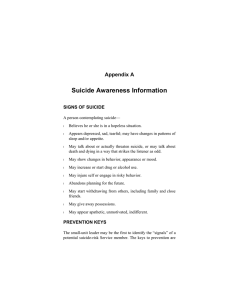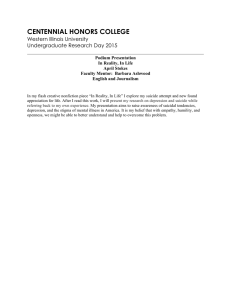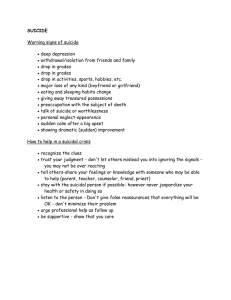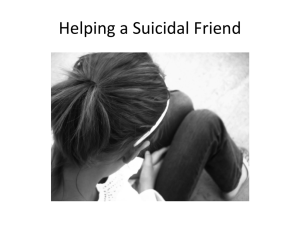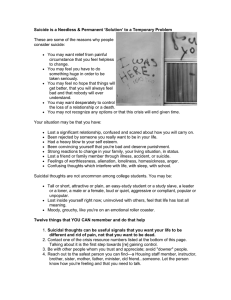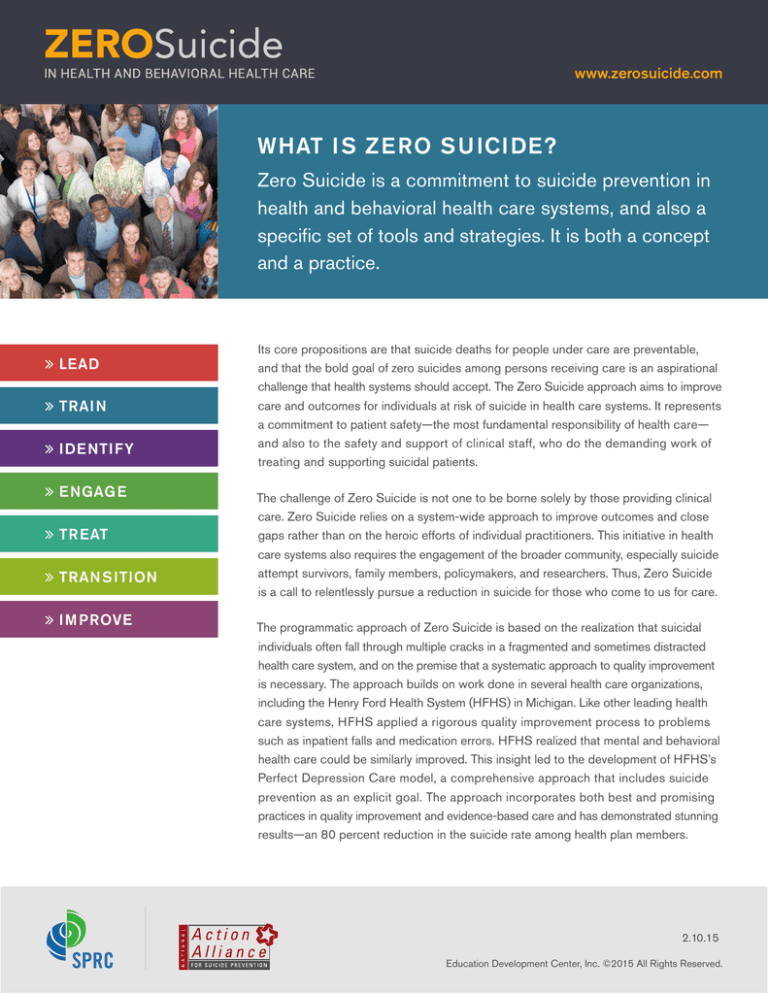
www.zerosuicide.com
WHAT I S Z E RO S U ICI DE?
Zero Suicide is a commitment to suicide prevention in
health and behavioral health care systems, and also a
specific set of tools and strategies. It is both a concept
and a practice.
Its core propositions are that suicide deaths for people under care are preventable,
and that the bold goal of zero suicides among persons receiving care is an aspirational
challenge that health systems should accept. The Zero Suicide approach aims to improve
care and outcomes for individuals at risk of suicide in health care systems. It represents
a commitment to patient safety—the most fundamental responsibility of health care—
and also to the safety and support of clinical staff, who do the demanding work of
treating and supporting suicidal patients.
LEAD
TRAI N
I DE NTI FY
E NGAG E
TR EAT
TRAN S ITION
I M PROVE
The challenge of Zero Suicide is not one to be borne solely by those providing clinical
care. Zero Suicide relies on a system-wide approach to improve outcomes and close
gaps rather than on the heroic efforts of individual practitioners. This initiative in health
care systems also requires the engagement of the broader community, especially suicide
attempt survivors, family members, policymakers, and researchers. Thus, Zero Suicide
is a call to relentlessly pursue a reduction in suicide for those who come to us for care.
The programmatic approach of Zero Suicide is based on the realization that suicidal
individuals often fall through multiple cracks in a fragmented and sometimes distracted
health care system, and on the premise that a systematic approach to quality improvement
is necessary. The approach builds on work done in several health care organizations,
including the Henry Ford Health System (HFHS) in Michigan. Like other leading health
care systems, HFHS applied a rigorous quality improvement process to problems
such as inpatient falls and medication errors. HFHS realized that mental and behavioral
health care could be similarly improved. This insight led to the development of HFHS’s
Perfect Depression Care model, a comprehensive approach that includes suicide
prevention as an explicit goal. The approach incorporates both best and promising
practices in quality improvement and evidence-based care and has demonstrated stunning
results—an 80 percent reduction in the suicide rate among health plan members.
2.10.15
SPRC
Suicide Prevention Resource Center
Education Development Center, Inc. ©2015 All Rights Reserved.
www.zerosuicide.com
Using these successful approaches as the basis for its
recommendations, the Clinical Care and Intervention
Task Force of the National Action Alliance for Suicide
Prevention identified essential elements of suicide
prevention for health care systems (i.e., health care
plans or care organizations serving a defined population
of consumers, such as behavioral health programs,
integrated delivery systems, and comprehensive primary
care programs). These elements include:
1
LEAD Create a leadership-driven, safety-oriented
culture committed to dramatically reducing suicide
among people under care. Include suicide attempt
and loss survivors in leadership and planning roles.
2
TRAIN Develop a competent, confident, and
caring workforce.
3
I DENTIFY Systematically identify and assess suicide
risk among people receiving care.
4
E NGAGE Ensure every person has a suicide care
management plan, or pathway to care, that is both
timely and adequate to meet his or her needs. Include
collaborative safety planning and restriction of lethal means.
5
TREAT Use effective, evidence-based treatments that
directly target suicidality.
6
TRANSITION Provide continuous contact and
support, especially after acute care.
7
I MPROVE Apply a data-driven quality improvement
approach to inform system changes that will lead to
improved patient outcomes and better care for those
at risk.
If we do not set big goals, we will never achieve them. In the
words of Thomas Priselac, president and CEO of CedarsSinai Medical Center:
“It is critically important to design for zero even when
it may not be theoretically possible. When you design
for zero, you surface different ideas and approaches
that if you’re only designing for 90 percent may not
materialize. It’s about purposefully aiming for a higher
level of performance.”
Better performance and accountability for suicide prevention
and care should be core expectations of health care programs
and systems. While we do not yet have proof that suicide can
be eliminated in health systems, we do have strong evidence
that system-wide approaches are more effective.
To assist health and behavioral health plans and organizations,
the Suicide Prevention Resource Center (SPRC) offers an
evolving online toolkit that includes modules and resources
to address each of the elements listed above. SPRC also
provides technical assistance for organizations actively
implementing this approach.
Learn more at www.zerosuicide.com.
FOR MOR E I N FOR MATION, PLEAS E CONTACT:
Julie Goldstein Grumet, PhD
Director of Prevention and Practice
Suicide Prevention Resource Center
Education Development Center, Inc.
1025 Thomas Jefferson Street, NW
Suite 700W
Washington, DC 20007
Phone: 202.572.3721
Email: jgoldstein@edc.org

